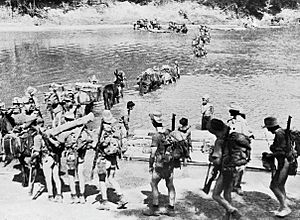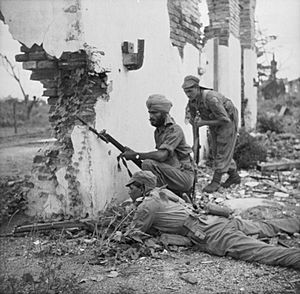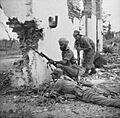South-East Asian theatre of World War II facts for kids
Quick facts for kids South-East Asian Theatre |
|||||||
|---|---|---|---|---|---|---|---|
| Part of the Pacific War of World War II | |||||||
 A Chindit column crosses a river in Burma, 1943 |
|||||||
|
|||||||
| Belligerents | |||||||
|
Japanese People's Emancipation League |
|
||||||
| Commanders and leaders | |||||||
|
|
||||||
| Strength | |||||||
| 341,400 people 33 warships 41 submarines 492 planes 20 tanks |
582,700 people 70 warships 18 submarines 708 planes 134 tanks |
||||||
| Casualties and losses | |||||||
| 82,200 casualties 202,700 people captured |
222,000 casualties | ||||||
The South-East Asian Theatre was a major part of the Pacific War during World War II. It involved fighting in countries like the Philippines, Thailand, Indonesia, Indochina, Burma, India, Malaya, and Singapore.
The conflict in this region began on December 8, 1941, when Japan launched surprise attacks. These attacks happened at almost the same time as the famous Attack on Pearl Harbor. The war in this theatre ended when Japan decided to surrender on August 15, 1945. The official surrender ceremony took place on September 2, 1945.
Contents
How the War Started
The fighting in this area actually began earlier, in September 1940. That's when the Empire of Japan invaded French Indochina. But the war really exploded on December 7 and 8, 1941. Japan launched surprise attacks on places like Hong Kong, the Philippines, Thailand, Singapore, and Malaya.
Japan declared war on the United States and the British Empire. However, these declarations were delivered after the attacks had already started. On December 8, the United Kingdom, United States, Canada, and the Netherlands declared war on Japan. China and Australia followed the next day.
Japan's Early Victories
The Allied forces faced many defeats at the start of the war. Two large British warships, HMS Repulse and HMS Prince of Wales, were sunk by Japanese planes off Malaya on December 10, 1941. After Japan invaded, the government of Thailand officially joined forces with Japan on December 21.
Japan also invaded Hong Kong in the Battle of Hong Kong on December 8. Hong Kong surrendered on December 25. In January, Japan invaded Burma and the Dutch East Indies. They also captured important cities like Manila and Kuala Lumpur.
The Fall of Malaya and Singapore
Japanese forces faced strong resistance in the Battle of Malaya. They fought against soldiers from the Indian Army, the Australian 8th Division, and British units. However, Japan had better air power, more tanks, and smarter infantry tactics. This forced the Allied units to retreat.
By the end of January 1942, the Allies were pushed out of Malaya. The Allied forces in Singapore, led by Lieutenant General Arthur Percival, surrendered to the Japanese on February 15, 1942. About 130,000 Allied soldiers became prisoners of war. The fall of Singapore was the largest surrender in British military history.
Japan's Attack in the Indian Ocean
From March 31 to April 10, 1942, the Japanese Navy launched a big attack called the Indian Ocean raid. They used their powerful aircraft carriers to target Allied ships and bases in the Indian Ocean. Japan wanted to destroy British naval power there and help their invasion of Burma.
The raid was somewhat successful. It didn't completely destroy the Allied navy in the Indian Ocean. But it did make the British fleet move from British Ceylon to Kilindini in Mombasa, Kenya. Their usual bases were not safe from Japanese attacks.
In 1942, Madras City in India was attacked by a Japanese seaplane. It dropped a bomb near St. George Fort. The damage was small, but people were very scared. Many wealthy families left Madras and moved to safer places in the hills.
Japanese Control of the Andaman and Nicobar Islands
The Andaman and Nicobar Islands are a group of islands in the Bay of Bengal. They are about 780 miles from Kolkata and 120 miles from Cape Nargis in Burma. On March 23, 1942, a Japanese invasion force took control of these islands. They occupied them until the end of the war.
Later, on December 29, 1943, the Japanese officially gave control of the islands to the Azad Hind government. This was a government led by Subhas Chandra Bose, who wanted India to be free from British rule. Bose even visited Port Blair to raise the flag of the Indian National Army. However, the Japanese still held the real power. The islands were renamed "Shaheed" (meaning "martyr") and "Swaraj" (meaning "self-rule").
The Burma Campaign

The Burma Campaign was a very important part of the war in Southeast Asia. It involved many battles and movements of troops.
- The British forces in Burma had to retreat early in the war.
- The British Fourteenth Army was formed, and it became known as the "Forgotten Army."
- There was a long fight called the Arakan Campaign.
- Japan tried to attack India.
- The Allies launched strong counter-attacks to push back the Japanese.
- One goal was to open the road to Rangoon.
- Special forces called the Chindits, led by Brigadier Orde Wingate, fought behind enemy lines.
US Forces in the China Burma India Theatre
American forces also played a big role in this theatre, often called the CBI (China Burma India) Theatre.
- The Northern Combat Area Command (NCAC) was a key American-led group.
- The Flying Tigers were famous American volunteer pilots.
- The Fourteenth Air Force and Tenth Air Force were important air units.
- The Twentieth Air Force carried out Operation Matterhorn, bombing missions.
- A huge effort was made to fly supplies over the the Hump (the Himalayas) from India to China.
- The Ledo Road was built to provide a land route for supplies.
- Merrill's Marauders were a special American long-range jungle fighting unit.
"Flying the Hump" over the Himalayas and building the Ledo Road were two of the biggest supply challenges of the war. They were vital for getting resources to China.
Air War in Southeast Asia
The air forces played a crucial role in the South East Asian Theatre.
- The RAF Far East Air Force and RAF Third Tactical Air Force were British air commands.
- There were many bombing campaigns from 1944 to 1945.
The Royal Air Force (RAF) earned special honors for their actions:
- CEYLON 1942: For defending British Ceylon against Japanese air and naval attacks in April 1942.
- BURMA 1944–1945: For supporting the 14th Army's advance and other operations in Burma from August 1944 to August 1945.
At first, successes in the Indian Ocean were achieved by using mines and submarines. The Japanese were not very good at clearing mines. British submarines based in British Ceylon attacked Japanese ships.
Later in the war, as the fighting in Europe began to end, more British naval forces were sent to the Indian Ocean. From late 1944, British aircraft carriers launched attacks against oil targets in Sumatra. These attacks, like Operation Meridian, heavily damaged Japanese oil facilities. This made Japan's fuel shortages even worse. The American ship USS Saratoga even helped in the first attack.
After the main battle fleets left to form the British Pacific Fleet, the Indian Ocean still had escort carriers and older battleships. These ships were important for helping to retake Burma. They supported landings on Ramree and Akyab, and near Rangoon.
How the Forces Were Organized
Allied Command Structure
At the start of the war, British forces in the area were under different commands. General Sir Archibald Wavell was the Commander-in-Chief in India. He led British and Indian armies in India and Burma.
In December 1941, after Japan attacked, the Allied governments created a new command. General Wavell was made the Supreme Allied Commander of all "American-British-Dutch-Australian" (ABDA) forces. This command covered Southeast Asia and the Pacific.
However, Japan's quick advances split the ABDA forces. In February 1942, the ABDACOM was closed down. Wavell went back to India to lead the defense of Burma.
In August 1943, the Allies formed a new command called the South East Asia Command (SEAC). This command was responsible for all strategic operations in the theatre. On October 4, Winston Churchill appointed Admiral Lord Louis Mountbatten as the supreme Allied commander of SEAC. The American General Joseph Stilwell was his deputy.
SEAC's main area of operations included India, Burma, British Ceylon, and Malaya. They also launched operations in Japanese-occupied Sumatra, Thailand, and French Indochina (Vietnam, Cambodia, and Laos).
SEAC commanded:
- The British Eastern Fleet (based in Ceylon).
- The British 11th Army Group (Commonwealth land forces).
- Air HQ India (air forces).
- The China Burma India Theater (CBI), which included all US forces.
In October 1944, the CBI was split into two separate US commands. On August 15, 1945, responsibility for the rest of the Dutch East Indies was given to SEAC. SEAC was officially ended on November 30, 1946.
Japanese Command Structure
The Imperial Japanese Army had a main command called the Southern Expeditionary Army Group. It was based in Saigon, Indochina. General Count Hisaichi Terauchi led this group from 1941 to 1945.
The Japanese also used the South Seas Force. This was a mix of army and special naval troops. The Southern Army's main field commands included the 14th Army, the 15th Army, the 16th Army, and the 25th Army. These forces had many infantry divisions, brigades, and tank regiments. The Japanese often used bicycle infantry, which helped them move quickly over long distances.
Images for kids
See Also
- Burma National Army
- Thai Phayap Army
- Korean Liberation Army
- Military history of Britain during World War II#The Far East
- Second Sino-Japanese War
- Kantogun



